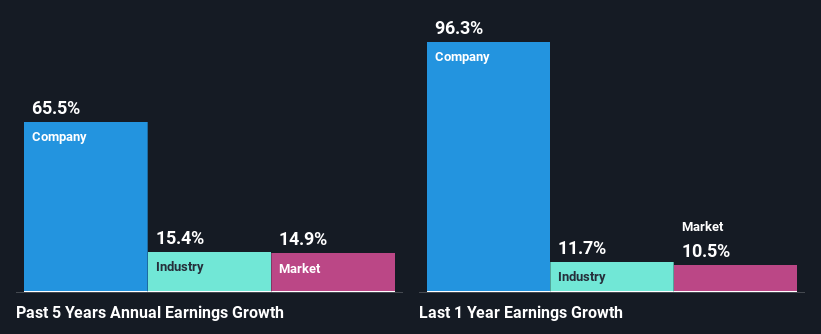- Saudi Arabia
- /
- Electrical
- /
- SASE:1303
Is Electrical Industries Company's (TADAWUL:1303) Latest Stock Performance A Reflection Of Its Financial Health?

Electrical Industries' (TADAWUL:1303) stock is up by a considerable 18% over the past three months. Since the market usually pay for a company’s long-term fundamentals, we decided to study the company’s key performance indicators to see if they could be influencing the market. Specifically, we decided to study Electrical Industries' ROE in this article.
ROE or return on equity is a useful tool to assess how effectively a company can generate returns on the investment it received from its shareholders. In simpler terms, it measures the profitability of a company in relation to shareholder's equity.
See our latest analysis for Electrical Industries
How To Calculate Return On Equity?
Return on equity can be calculated by using the formula:
Return on Equity = Net Profit (from continuing operations) ÷ Shareholders' Equity
So, based on the above formula, the ROE for Electrical Industries is:
35% = ر.س292m ÷ ر.س834m (Based on the trailing twelve months to June 2024).
The 'return' refers to a company's earnings over the last year. So, this means that for every SAR1 of its shareholder's investments, the company generates a profit of SAR0.35.
What Has ROE Got To Do With Earnings Growth?
Thus far, we have learned that ROE measures how efficiently a company is generating its profits. Depending on how much of these profits the company reinvests or "retains", and how effectively it does so, we are then able to assess a company’s earnings growth potential. Generally speaking, other things being equal, firms with a high return on equity and profit retention, have a higher growth rate than firms that don’t share these attributes.
Electrical Industries' Earnings Growth And 35% ROE
To begin with, Electrical Industries has a pretty high ROE which is interesting. Second, a comparison with the average ROE reported by the industry of 7.9% also doesn't go unnoticed by us. So, the substantial 66% net income growth seen by Electrical Industries over the past five years isn't overly surprising.
As a next step, we compared Electrical Industries' net income growth with the industry, and pleasingly, we found that the growth seen by the company is higher than the average industry growth of 15%.

Earnings growth is a huge factor in stock valuation. The investor should try to establish if the expected growth or decline in earnings, whichever the case may be, is priced in. This then helps them determine if the stock is placed for a bright or bleak future. If you're wondering about Electrical Industries''s valuation, check out this gauge of its price-to-earnings ratio, as compared to its industry.
Is Electrical Industries Using Its Retained Earnings Effectively?
Electrical Industries has a significant three-year median payout ratio of 67%, meaning the company only retains 33% of its income. This implies that the company has been able to achieve high earnings growth despite returning most of its profits to shareholders.
Additionally, Electrical Industries has paid dividends over a period of at least ten years which means that the company is pretty serious about sharing its profits with shareholders.
Summary
On the whole, we feel that Electrical Industries' performance has been quite good. We are particularly impressed by the considerable earnings growth posted by the company, which was likely backed by its high ROE. While the company is paying out most of its earnings as dividends, it has been able to grow its earnings in spite of it, so that's probably a good sign. Until now, we have only just grazed the surface of the company's past performance by looking at the company's fundamentals. To gain further insights into Electrical Industries' past profit growth, check out this visualization of past earnings, revenue and cash flows.
Valuation is complex, but we're here to simplify it.
Discover if Electrical Industries might be undervalued or overvalued with our detailed analysis, featuring fair value estimates, potential risks, dividends, insider trades, and its financial condition.
Access Free AnalysisHave feedback on this article? Concerned about the content? Get in touch with us directly. Alternatively, email editorial-team (at) simplywallst.com.
This article by Simply Wall St is general in nature. We provide commentary based on historical data and analyst forecasts only using an unbiased methodology and our articles are not intended to be financial advice. It does not constitute a recommendation to buy or sell any stock, and does not take account of your objectives, or your financial situation. We aim to bring you long-term focused analysis driven by fundamental data. Note that our analysis may not factor in the latest price-sensitive company announcements or qualitative material. Simply Wall St has no position in any stocks mentioned.
About SASE:1303
Electrical Industries
Through its subsidiaries, engages in the manufacture, assembly, supply, and maintenance of various electrical equipment; and provision of technical services in the Kingdom of Saudi Arabia, other Gulf countries, Europe, and Asia.
Outstanding track record with excellent balance sheet and pays a dividend.


